Newest Innovation In The World Of NFT’s
The world of NFTs is an ever-evolving landscape, characterized by innovation, creativity, and rapid change. These digital assets have captured the imagination of artists, collectors, investors, and tech enthusiasts alike. As we delve into what’s new in the world of NFT developments, it becomes evident that this blockchain-based ecosystem continues to expand and redefine the boundaries of digital ownership.
1. Metaverse Integration
One of the most significant recent developments in the NFT space is the integration of NFTs into the metaverse. Metaverse platforms are virtual, interconnected worlds where users can interact, socialize, and conduct business. NFTs are becoming the digital passports to these metaverse experiences. From virtual real estate purchases to unique wearables for avatars, NFTs are at the forefront of metaverse economies.
2. Dynamic NFTs
Traditionally, NFTs have been static digital assets, representing images, videos, or music. However, dynamic NFTs are now making waves. These NFTs can change over time or in response to certain conditions. For example, an artwork could evolve based on the weather or the viewer’s actions. Dynamic NFTs introduce an entirely new dimension of interactivity and storytelling to the NFT space.
3. NFTs in the Music Industry
Musicians and artists are increasingly exploring NFTs as a means of connecting with their fans and monetizing their work. Recent developments include musicians releasing exclusive albums or concert tickets as NFTs, giving fans unique digital experiences and ownership rights. This trend is reshaping the music industry’s revenue model and fostering direct artist-fan relationships.
4. NFT Gaming
NFTs and blockchain technology have also disrupted the gaming industry. Players can now truly own in-game assets as NFTs, allowing for the transfer and trade of virtual items across games. Game developers are integrating blockchain into their ecosystems, enabling players to have genuine ownership of digital goods, characters, and even land within virtual worlds.
5. Environmental Concerns
While NFTs have brought immense innovation, they have also raised concerns about their environmental impact. Many NFTs are built on energy-intensive blockchain networks like Ethereum. The industry is responding by exploring more eco-friendly alternatives, such as NFTs on Layer 2 solutions and blockchain networks that use less energy.
6. Legal and Copyright Issues
As the NFT space matures, legal and copyright challenges have come to the forefront. Ensuring that NFTs respect intellectual property rights and adhere to copyright laws is an ongoing concern. Legal frameworks are evolving to address these issues, and industry standards are being developed to promote ethical practices.
7. NFT Marketplaces and Standards
NFT marketplaces continue to proliferate, offering artists and collectors diverse platforms to buy, sell, and trade NFTs. Additionally, industry standards and protocols, such as ERC-721 and ERC-1155 on Ethereum, are being refined to enhance NFT interoperability and utility.
8. Education and Awareness
With the rapid growth of the NFT ecosystem, there is an increasing need for education and awareness. Organizations and communities are emerging to provide resources and guidance on NFT creation, investment, and security. These initiatives aim to ensure that both creators and collectors can navigate the NFT space confidently.
9. Cross-Chain Compatibility
As the NFT market continues to expand, interoperability between different blockchain networks has become a focus of development. Projects are emerging to bridge the gap between blockchains, allowing NFTs to move seamlessly across different platforms. This cross-chain compatibility enhances the liquidity and utility of NFTs, making them more accessible to a broader audience.
10. NFT Market Data and Analytics
With the increasing prominence of NFTs, data and analytics services specific to the NFT market have emerged. These platforms provide valuable insights into market trends, pricing, and the performance of different NFT collections. Investors and collectors can use this information to make informed decisions, similar to traditional financial markets.
11. Virtual Real Estate
In virtual worlds and metaverse platforms, virtual real estate has become a significant NFT category. Users are buying and trading digital land parcels, which can serve as spaces for social gatherings, business ventures, or art installations within virtual environments. Virtual real estate represents a novel frontier for NFT ownership and development.
12. NFT Backed Loans and Financial Services
The concept of using NFTs as collateral for loans and financial services is gaining traction. NFT-backed lending platforms allow users to borrow against their NFT assets, providing liquidity without selling their prized collectibles. This financial innovation bridges the gap between the digital and physical worlds of asset ownership.
13. Charitable and Social Impact NFTs
NFTs are also being leveraged for charitable causes and social impact initiatives. Artists and creators are minting NFTs with a portion of the proceeds dedicated to charitable organizations or community projects. This trend highlights the potential for NFTs to contribute to positive societal change.
14. NFT Authentication and Provenance
Maintaining the authenticity and provenance of NFTs has become increasingly important. Solutions are being developed to track the history and ownership of NFTs, ensuring that buyers can verify the legitimacy of their digital assets. This transparency adds value and trust to the NFT ecosystem.
15. In-Game Economies Powered by NFTs
Beyond individual game items, entire in-game economies are emerging based on NFTs. Gamers can buy, sell, and trade NFT-based assets within virtual worlds, creating new opportunities for economic interactions and entrepreneurship within gaming ecosystems.
16. The Role of AI and Generative Art
AI-generated and generative art NFTs are gaining popularity. These artworks are created using algorithms and artificial intelligence, adding a new dimension to digital creativity. The fusion of AI and NFTs is reshaping the art world and challenging traditional notions of authorship.
Conclusion
The world of NFT marketplace development is a dynamic and ever-expanding realm, driven by technological advancements, creative innovation, and evolving user needs. From metaverse integration to dynamic NFTs, the NFT space continues to push boundaries and redefine digital ownership. However, it also faces challenges related to environmental impact, legal considerations, and the need for greater education and awareness.






